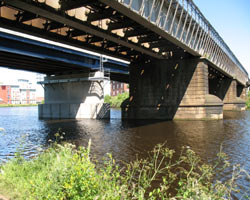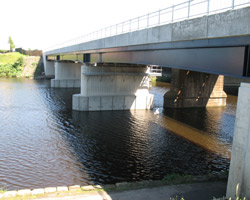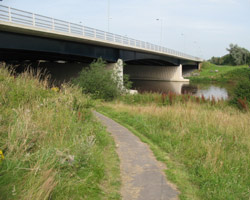
STOCKTON RAILWAY BRIDGES

"A suspension bridge for the railway was not used before so it was decided to test it. The first bridge failed due to lack of stiffness and excessive deflection, it had to be suported by trestles set in the bed of the river. It was replaced in 1844 by an iron trussed girder bridge by Robert Stephenson."
Bridges Over the Tees. C H Morris. 2000
There are two rail bridges at this location, the downstream one now being disused. The first rail bridge here, linking Stockton with the then small settlement of Middlesbrough, dated from 1830 and was the world's first railway suspension bridge, but was not a success, and was eventually replaced in 1844 by a 3 span trussed iron girder bridge designed by Robert Stephenson. Failure of similar designs elsewhere led to its being strengthened and eventually to its replacement by another bridge built alongside in 1882 when the use of cast iron was prohibited on main line railway bridges after a further failure of a bridge in Scotland. Plans to add an extra two tracks to the railway had already been well under way and the new bridge was quickly completed, taking the form of a riveted wrought iron plate girder bridge on cylindrical piers. The design of Stephenson's 1844 bridge caused congestion and so had its cast iron girders replaced in 1906 with mild steel plate girders. In 2008/09 the 1882 bridge which had been disused and had its tracks lifted was demolished, and a new bridge of steel and concrete on concrete piers erected in its place by Network Rail and Carillion Ciovil Engineering and designers HBPW Partners. The Stephenson bridge is not now used by rail traffic but still carries cables.
Railway traffic over the bridges increased enormously as Teesside developed and despite some recent industrial decline, still remains busy with both freight and passenger trains.
- Constructed - 1. 1844/1906
2. 2008/09 - Type - 1. beam, steel girder on masonry piers.
2. beam, concrete and steel, 3 span. - Position: Stockton-on-Tees.
- Grid Ref: NZ 446 179






